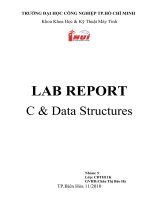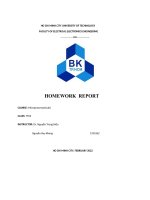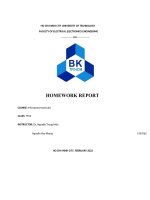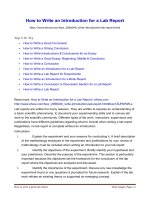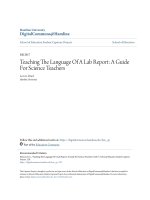Report biochemistry lab 2
Bạn đang xem bản rút gọn của tài liệu. Xem và tải ngay bản đầy đủ của tài liệu tại đây (508.37 KB, 25 trang )
CAN THO UNIVERSITY
PRACTICE REPORT
BIOCHEMISTRY LABORATORY II
CODE BT231
TABLE OF CONTENTS
2. The principle of a spectroscopic method .............................................. 2
3. Extraction of crude bromelain from pineapple ..................................... 2
4. Precipitation of protein by ammonium sulphate................................... 4
5. Determining protein content by the Bradford method .............................. 7
6. Determining specific activity of enzymes by the Kunitz method .......... 15
7. Determining molecular weight of protein by SDS-PAGE ...................... 21
2.
The principle of a spectroscopic method
- Introduction: Spectrophotometry is a general analytical method in analytical
laboratories that can be used for identification or measurement. This measurement can also
be used to measure the amount of a known chemical substance.
- Principle:
+ The basic principle is that each compound absorbs or transmits light over a certain range
of wavelengths. In other words, is to shine a beam of electromagnetic radiation onto a
sample and observe how it responds to such a stimulus. The response is usually recorded
as a function of radiation wavelength.
+ Includes absorption of ultraviolet, normal light, or infrared radiation used in
quantification.
+ Absorption of light usually occurs with substances:
Organic molecules, Metal, and Metal-organic complex.
- UV (170nm to 380nm): use ultraviolet light to determine the absorbency of a substance.
As matter absorbs light, it generates a spectrum.
- VIS (380nm to 780nm): based on the absorption of visible light by chemical compounds,
which results in the production of distinct spectra. The UV-VIS spectroscopic method is
used to quantify the amount of DNA or protein in a sample, for water analysis, and as a
detector for many types of chromatography.
3.
Extraction of crude bromelain from pineapple
-
Purpose: Extract the crude bromelain from unripe pineapple.
Principle: The crude bromelain is extracted from pineapple through
centrifugation. The enzymatic extract is subjected to centrifugation for eliminating cellular
debris, organelles, and other molecular aggregates, thereby leading to partial purification
of enzymes.
2
It also assists towards the enzymatic characterization as depending on the mass as
well as shape, the enzyme will travel over solution with a definite velocity and occupy a
distinctive position in the centrifuge tube.
3.1.
-
Material: unripe pineapple.
-
Consumable: eppendorf tube, plastic graduated cylinder.
-
Equipment: micropipette, pipette tip.
A protocol for extraction of crude bromelain from pineapple
To describe steps
-
The unripe pineapple is cut into three parts: skin, flesh, and core.
-
The blender is used to grind. Then, the liquid is filtered.
The liquid is poured into centrifuge tube. The tube needs to be measured
carefully before putted into centrifuge.
After centrifugation, a micropipette is used to transfer the liquid slowly into
a plastic graduated cylinder. The volume is noted.
-
The liquid is continued to be centrifuged again.
After centrifugation, a micropipette is used to transfer the liquid slowly into
a plastic graduated cylinder. The volume is noted.
The final liquid is crude bromelain. It must be stored in eppendorf tubes at
low temperature (about 4oC).
3.2.
Parameter
Weight (gram)
3
%
Volume (mL)
A pineapple fruit
1291
Part 1 (skin)
307,97
76.63%
236
Part 2 (flesh)
706,1
51.55%
364
Part 3 (core)
24,81
604.59%
150
3.2. Statistics about amount of pineapple fruit (Tons)
Province
Group Species of 2020
pineapple
2019
2018
2017
Long An (tons)
A
Queen
14,076
13,145
14,152
13,215
Tien Giang (tons)
B
Queen
250,000 300,000 244,000 123,500
Hau Giang (tons)
C
Queen
28,327
27,319
22,880
16,240
Kien Giang (tons)
D
Queen
115,000 91,050
75,780
51,750
4.
Precipitation of protein by ammonium sulphate
4.1
Introduction
Purpose: The main purpose of protein precipitation is to separate the protein
from the solution either to eliminate interferences or to purify them. Depending on the
solubility and molecular structure of the protein, the efficacy of various precipitation
methods can be different.
Principle of protein precipitation by Ammonium Sulphate: When high
concentrations of small, highly charged ions such as Ammonium Sulfate are added, these
groups compete with the proteins to bind to the water molecules. This removes the water
molecules from the protein and decreases its solubility, resulting in precipitation.
Ammonium Sulfate including other salts are exploited towards precipitation in a
process known as “salting out”.
Principle of dialysis: Dialysis works on the principles of the diffusion of
solutes and ultrafiltration of fluid across a semi-permeable membrane. Diffusion is a
property of substances in water; substances in water tend to move from an area of high
concentration to an area of low concentration.
4
Material: Crude Bromelain
solution.
Chemical: Ammonium Sulfate, Ammonium Acetate Buffer 0.1M pH 4
Consumable: beaker, plastic graduated cylinder, glass rod, plastic transfer
pipettes, eppendorf tube, dialysis-tubing bag.
-
Equipment: analytical balance 3 digits, centrifuge tube, centrifuge.
4.2. Saturated precipitation of protein
To describe steps for saturated precipitation of protein by 80% AS
5.61g Ammonium Sulfate is measured by analytical balance 3 digits and the value
is noted.
10mL Crude Bromelain is measures by a plastic graduated cylinder. Then, Crude
Bromelain is poured into a beaker containing 5.61g Ammonium Sulfate.
The mixture is stirred by a glass rod until 5.61g Ammonium Sulfate is dissolved in
10mL Crude Bromelain completely. Wait 30 minutes until protein is precipitated.
The mixture is poured into centrifuge tube. The tube needs to be
measured carefully before putted into centrifuge. The mixture is centrifuged for 30
minutes.
After 30 minutes, centrifuge tube is taken out. Then, plastic transfer pipettes are
used to remove the liquid, the saturated precipitation of protein by 80% AS is saved.
4.3.
Fraction precipitation of protein
To describe steps for fraction precipitation of protein by 50% and 75% AS
Fraction precipitation of protein by 50% AS
3.14g Ammonium Sulfate is measured by analytical balance 3 digits and the value
is noted.
10mL Crude Bromelain is measures by a plastic graduated cylinder. Then, Crude
Bromelain is poured into a beaker containing 3.14g Ammonium Sulfate.
5
The mixture is stirred by a glass rod until 3.14g Ammonium Sulfate is dissolved in
10mL Crude Bromelain completely. Wait 30 minutes until protein is precipitated.
The mixture is poured into centrifuge tube. The tube needs to be measured carefully
before putted into centrifuge. The mixture is centrifuged for 30 minutes.
After 30 minutes, centrifuge tube is taken out. Then, plastic transfer pipettes are
used to transfer the liquid into a plastic graduated cylinder. The volume is noted to prepare
for fraction precipitation of protein by 75% AS.
Fraction precipitation of protein by 75% AS
1.892g Ammonium Sulfate is measured by analytical balance 3 digits and the value
is noted.
11mL liquid of protein by 50% AS in the previous experiment is measures by a
plastic graduated cylinder. Then, protein by 50% AS is poured into a beaker containing
3.14g Ammonium Sulfate.
The mixture is stirred by a glass rod until 1.892g Ammonium Sulfate is dissolved
in 11mL liquid of protein by 50% AS completely. Wait 30 minutes until protein is
precipitated.
The mixture is poured into centrifuge tube. The tube needs to be measured carefully
before putted into centrifuge. The mixture is centrifuged in 30 minutes.
After 30 minutes, centrifuge tube is taken out. Then, a plastic transfer pipettes a
plastic transfer pipette is used to remove the liquid, the fraction precipitation of protein by
75% AS is saved.
4.4.
Dialysis
To describe steps for
3 dialysis-tubing bags are prepared. The volumes of precipitation of protein
by 80% AS, 50% AS and 75% AS are measured by a plasic graduated cylinder and noted.
Then, they are put into each different bag.
6
5mL of Ammonium Acetate Buffer 0.1M pH 4 solution is measured by a
plastic graduated cylinder. Then, it is added into each bag.
3 bags are put into a beaker containing Ammonium Acetate Buffer 0.1M pH
4 solution. The beaker needs to be saved at low temperatures. The solution must be changed
after 4-5 hours. Repeat at least three times.
The volumes of precipitation of protein by 80% AS, 50% AS and 75% AS
are measured again after dialysis and stored in eppendorf tubes at low temperature (about
4oC).
4.5. Result and storage
Volume
(Before precipitation) (mL)
Volume
(After dialysis) (mL)
AS 80%
5.2 mL
4.5 mL
AS 50%
6 mL
5 mL
AS 75%
8 mL
8.2 mL
- Storage: The volumes of precipitation of protein by 80% AS, 50% AS and 75%
AS are stored in eppendorf tubes at low temperature (about 4oC).
5. Determining protein content by the Bradford method
Purpose: The Bradford assay is a dye-binding assay used to measure the
protein concentration of a solution. The aim of following experiment is to determine the
protein content by the Bradford method using bovine serum albumin (BSA) in the solution
(crude bromelain, AS 80%, AS 50%, AS 75% are used in these experiments).
Principle: The assay is based on the observation that the absorbance
maximum for an acidic solution of Coomassie Brilliant Blue (CBB) shifts from 465 nm to
595 nm when binding to protein occurs. Both hydrophobic and ionic interactions stabilize
the anionic form of the dye, causing a visible color change.
7
In acidic solution, when not bound to proteins, the red dye has a maximum
absorption wavelength of 465 nm and when combined with proteins, the dye turns blue
and absorbs maximum at the maximum level is at 595 nm. The absorbance at 595 nm is
directly related to the protein concentration.
Figure 5.1. Coomassie Brilliant Blue structure
Figure 5.2. Coomassie Brilliant Blue reaction
8
Material: Crude Bromelain, AS 80%, AS 50%, AS 75%.
-
Chemical: BSA 1mg/mL solution, CBB solution, Ammonium Acetate Buffer
0.1M pH 4 solution, distilled water.
-
Consumable: test tube, eppendorf tube.
-
Equipment: spectrophotometer, micropipette, pipette tip.
5.1. The BSA standard curve
-
Making the BSA standard curve
BSA
concentration
(µg/mL)
Volume of
BSA (µL)
0
30
60
120
180
240
300
0
30
60
120
180
240
300
1000
970
940
880
820
760
700
1000
1000
1000
1000
1000
1000
Volume of
distilled
water (µL)
Total volume
(µL)
* Notes: BSA Bovine serum albumin solution
9
1000
-
Reaction
BSA
0
30
Volume of BSA
(µL)
100
Volume of CBB
(µL)
2000
concentration
(µg/mL)
60
120
180
240
300
100
100
100
100
100
100
2000
2000
2000
2000
2000
2000
10 min.
OD1
0.,483
0,732
0,7575
0,801
0,937
0,995
1,120
OD2
0,474
0,662
0,7744
0,805
0,922
0,960
1,085
OD3
0,498
0,659
0,7646
0,823
0,913
0,946
1,158
Delta OD1
0,249
0,2745
0,318
0,454
0,512
0,637
Delta OD2
0,188
0,3004
0,331
0,448
0,486
0,611
Delta OD3
0,161
0,2666
0,325
0,415
0,448
0,66
Delta ODEverage
0,1993
0,2805
0,324
0,439
0,482
0,636
* Note: CBB: Coomassie brilliant blue solution
10
-
Drawing a standard curve
-
Equation : Y = 0,0015X + 0,1635 (Y = aX + b)
The equation obtained from the BSA standard curve is Y = 0,0015X + 0,1635, which
is X is the BSA concentration (µg/mL) and Y is the average of delta OD. This equation
obtained from the BSA standard curve (Y = 0,0015X + 0,1635) is able to be accurate
because the equation has R2 = 0.9726 (> 95%).
R2 in the chart is not nearly about 1, that meanss the errors still occur because of
some manipulation mistakes when using micropipette, diluting the samples, and recording
the results.
11
5.2.
The reaction between protein and Coomassie brilliant blue
-
Preparation of sample
Sample
Total volume for the
Dilution of 2 time Dilution of 5 time
experiment (mL)
Crude bromelain
6
x
x
AS80
4.5
x
x
AS50
5
x
x
AS75
8.2
x
x
- Making if dilution
+ 24 test tubes are prepared.
+ Dilution of 2 time (k = 2): the sample is diluted by Ammonium Acetate Buffer 0.1M pH
4 solution with the ratio 1:1 (300mL:300mL). The experiment is repeated 3 times.
+ Dilution of 5 time (k = 5): the sample is diluted by Ammonium Acetate Buffer 0.1M pH
4 solution with the ratio 1:4 (100mL:400mL). The experiment is repeated 3 times.
-
Reaction
Sample
Crude bromelain
AS80
AS50
Volume of sample
(µL)
100
Volume of CBB
(µL)
2000
AS75
10 min.
12
k
2
5
OD1
0.718
0.777
2
5
2
5
2
1.022 1.081 1.055 0.829 0.772
5
0.626
5.3.
OD2
0.771
0.646
1.089 0.818 1.192 0.829 0.586
0.688
OD3
0.933
0.667
1.014 0.736 1.013 0.712 0.668
0.567
Delta OD1
0.298
0.294
0.539 0.598 0.522 0.346 0.289
0.143
Delta OD2
0.297
0.172
0.615 0.344 0.718 0.355 0.112
0.214
Delta OD3
0.435
0.169
0.516 0.238 0.515 0.214
0.17
0.069
Delta ODEverage
0.322
0.212
0.557 0.393 0.585 0.305 0.190
0.142
Result
-
Protein content of the experiment
-
Equation : Y = 0,0015X + 0,1635 (Y = aX + b)
From the equation: Y = 0,0015X + 0,1635 obtained from the BSA standard curve (where
Y is the OD value and X is the concentration of protein (µg/mL)), we calculate the
concentration of protein in the enzyme.
Sample
k
Delta
ODEverage
Amount of
protein
(µg/mL)
Crude bromelain
AS80
2
5
2
0.322
0.212
0.557
105.667
32.333
262.333
AS50
5
2
0.393 0.585
153
281
AS75
5
2
5
0.305
0.190
0.142
94.333
17.667
0.000
Amount of
protein
0.211334 0.161665 0.524666 0.765 0.562 0.001525 0.035334 0.000
(mg/mL)
13
Total
volume for
the
experiment
3
3
63.4002
48.4995
2.25
2.25
2.5
2.5
4.1
4.1
0.4575
10.6002
0.000
(mL)
Total
protein for
the
experiment
157.3998 229.5 168.6
(mg)
Discussion
Theoretically, delta OD value must be decreased from the twofold diluted sample to the
fivefold diluted sample, that means the concentration of protein decreases from the twofold
dilution to the fivefold one so that after being multiplied by dilution coefficient. As we
observe in our results, the ΔOD value and the concentration of protein after dilution (x
value) is slightly decreased.
k=2, the total protein of concentration of 50% AS is highest. Next, 80% AS, crude
bromelain and 75 % AS is the smallest.
k=5, the total protein of concentration of 80% AS is highest. Next, crude bromelain,
50% AS and 75 % AS is the smallest.
Conclusion
We can conclude that the higher the diluted coefficient, the smaller the concentration
of protein.
14
- Total protein of a pineapple fruit (mg)
Sample
Crude bromelain
AS80
AS50
AS75
Total volume of a
6
pineapple fruit (mL)
4.5
5
8.2
Amount of protein
4.6
(mg/mL)
18.45956
15.0136
0.08146
Total protein in a
27.6
pineapple fruit (mg)
83.068
75.068
0.668
6. Determining specific activity of enzymes by the Kunitz method
- Purpose: The Kunitz assay is to identify the presence or quantity of a specific
enzyme in an organism, tissue, or sample.
- Principle: TCA (Tricarboxylic Acid) acts as an inhibitor that inhibits the activity of
enzymes. At the end of the incubation period, TCA is added. This stops the enzyme reaction
and denatures the casein, rendering it insoluble. The insoluble casein can then be removed
by centrifugation or filtration to yield a clear solution.
Casein is a kind of protein, which is made of amino acids with C-N linkages. In
hydrolysis reaction, enzymes will hydrolyze the C-N linkages of casein. In this assay,
casein acts as a substrate. When the protease we are testing digests casein, the amino acid
tyrosine is liberated along with other amino acids and peptide fragments. The more tyrosine
that is released from casein, the more the chromophores are generated and the stronger the
activity of the protease. Absorbance values generated by the activity of the protease are
compared to a standard curve, which is generated by reacting known quantities of tyrosine
with the F-C reagent to correlate changes in absorbance with the amount of tyrosine in
micromoles. From the standard curve the activity of protease samples can be determined
in terms of Units, which is the amount in micromoles of tyrosine equivalents released from
casein per minute.
15
6.1. The tyrosine standard curve
-
Making the tyrosine standard curve
Tyrosine
concentration
(µmol/mL)
0
0,2
0,4
0,6
0,8
1
0
300
600
900
1200
1500
Volume of HCl
0,1N (µL)
1500
1200
900
600
300
0
Total volume
(µL)
1500
1500
1500
1500
1500
1500
Volume of
Tyrosine (µL)
-
Reaction
Tyrosine
concentration
(µmol/mL)
0
0,2
0,4
0,6
0,8
1
OD1
0.049
0.304
0.552
0.804
1.081
1.327
OD2
0.051
0.296
0.587
0.801
1.068
1.337
OD3
0.049
0.04
0.569
0.815
1.074
1.326
Delta OD1
0.255
0.503
0.755
1.032
1.278
Delta OD2
0.245
0.536
0.75
1.017
1.286
Delta OD3
0.255
0.52
0.766
1.025
1.277
Delta ODEverage
0.252
0.52
0.757
1.025
1.28
16
-
Drawing a standard curve
-
Equation : Y = 1,2794X - 0,0007, R2 = 0,9998 (Y=aX + b)
The equation has R2 = 0.9886. The bigger R2 is, the more accurately equation
expresses. The chart leads to R2 = 0.9998 (> 95%), so we can conclude that the equation is
highly accurate.
However, the concentration of tyrosine in the solution is just accurate at the rate of
99.98%. The errors still occur because of some manipulation mistakes when using
micropipette, diluting the samples, and recording the results.
6.2.
Hydrolysis of casein
-
Reaction OD 280nm
Table 1. Preparing Samples.
Control samples
17
Enzyme samples
Step 1
Add to the Eppendorf tube: 160 µL
buffer solution, 20 µL enzyme, and
20 µL cysteine.
Incubating at 37
minutes
Step 2
Step 3
Incubating and shaking by
orbital shaker at
orbital
in 10 minutes.
37℃
Adding 600 µL casein 1%.
Centrifugating 6000 rpm at 4
10 minutes.
Incubating and shaking by
shaker at
in 10 minutes.
Adding 600 µL TCA 15%.
Stabilizing at 4 in 10
minutes.
in
Step 4
Centrifugating 6000 rpm at 4
in
10 minutes.
Measure the absorbance at 280 nm
wavelength.
* The experiment is repeated 3 times.
18
in 20
Adding 600 µL casein 1%.
Stabilizing at 4 in 10
minutes.
Step 5
Incubating at 37
minutes
in 20
Adding 600 µL TCA 15%.
37℃
Add to the Eppendorf tube: 160 µL
buffer solution, 20 µL enzyme, and 20
µL cysteine.
Measure the absorbance at 280 nm
wavelength.
6.3. Calculation of enzyme activity
-
Meaning:
U: activity in 1mL enzyme solution (U/mL) a: tyrosine concentration in hydrolyzed
solution (µM/mL)
Vt: total volume of the reaction solution (1400µL)
T: time of reaction (10 minutes)
VE: Volume of the enzyme used in reaction (20µL)
k: dilution coefficient In this experiment, samples do not need to be diluted, thus
k=1.
- Result
Crude bromelin
Unit of enzyme
activity (µg/mL) 4.361
6.4.
AS50
AS75
AS80
2.898
1.043
1.638
Result
Sample
Crude bromelain
AS50
AS75
AS80
Volume of sample
(µL)
20
20
20
20
OD (Control)
0.427
0.397
0.445
0.348
OD1
1.247
0.915
0.617
0.675
OD2
1.213
0.95
0.645
0.642
OD3
1.209
0.913
0.62
0.625
19
Delta OD (Control)
Delta OD1
0,82
0,518
0,172
0,327
Delta OD2
0,786
0,553
0,2
0,294
Delta OD3
0,782
0,516
0,197
0,277
Delta ODAverage
0,796
0,529
0,19
0,299
Discussion
Theoretically, the higher the concentration of enzyme, the stronger its activity
expresses. However, our results are the opposite. This error can be explained by our
mistakes when measuring the absorbance of the samples and maybe storing the samples.
Some samples may be put outside at room temperature for a long time, so the activity of
the enzyme may be altered.
Conclusion
Bromelain or papain break peptide bonds and release free amino acids after hydrolysis
with protein. In this case, tyrosine is released from casein after hydrolysis with bromelain
or papain enzyme.
Figure 1. Casein structure
20

